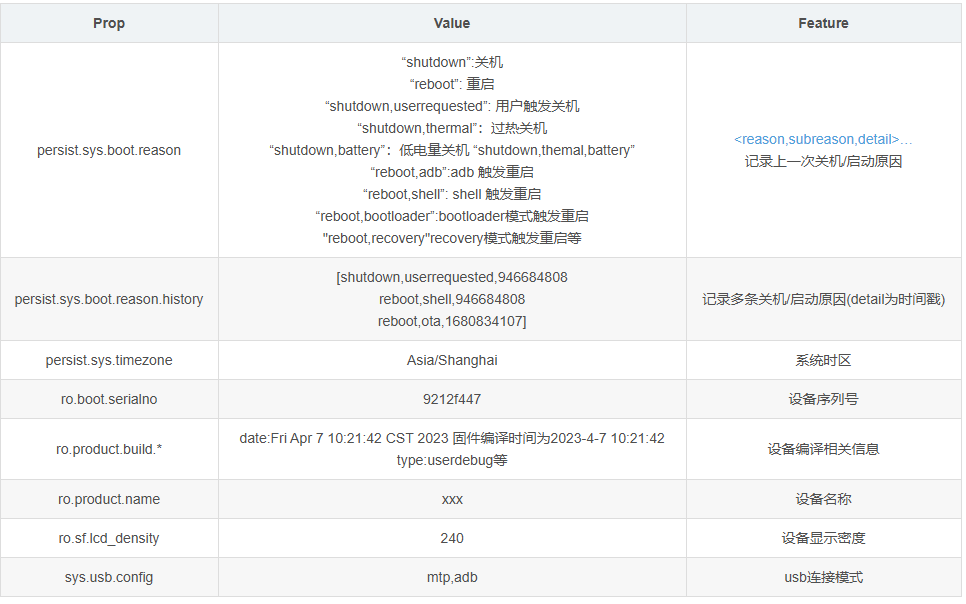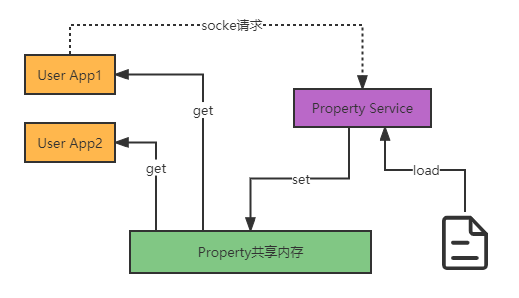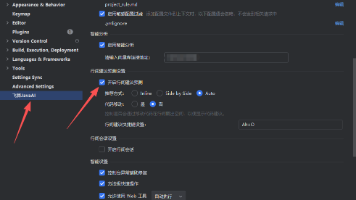安卓系统属性详解
Android系统中的SystemProperties机制用于管理系统级别的配置参数,通过键值对存储属性,具有只读/只写访问限制和层级存储特性。属性服务property_service由init进程启动,在SecondStageMain()中完成初始化、加载默认配置和启动服务。property_init()会创建共享内存目录并加载xxx_property_contexts文件,构建属性信息的序列化
目录
前言
SystemProperties 是Android系统中的一个关键机制,用于存储和管理系统级别的配置信息和参数。这些参数影响系统行为、硬件配置、调试选项、设备特性等。
它类似于“全局变量”或“配置项”,可以由多个系统组件读写,且具备以下特点
- 只读/只写访问限制:某些属性只能由系统权限较高的组件修改。
- 层级存储:存储在内存中,重启后可能保持或清除(依赖属性的定义和管理方式)。
- 属性名称常以类似“路径”的格式组织,例如:
ro.build.version.releasero.product.model - 属性以字符串键值对存储
以下是一些常用属性
一、属性服务property_service的启动流程
安卓版本 :10
平台:MTK
1.1 init–>SecondStageMain(argc, argv)
property_service 是 init进程 来初始化和启动的
system\core\init\main.cpp
int main(int argc, char** argv) {
#if __has_feature(address_sanitizer)
__asan_set_error_report_callback(AsanReportCallback);
#endif
if (!strcmp(basename(argv[0]), "ueventd")) {
return ueventd_main(argc, argv);
}
if (argc > 1) {
if (!strcmp(argv[1], "subcontext")) {
android::base::InitLogging(argv, &android::base::KernelLogger);
const BuiltinFunctionMap& function_map = GetBuiltinFunctionMap();
return SubcontextMain(argc, argv, &function_map);
}
if (!strcmp(argv[1], "selinux_setup")) {
return SetupSelinux(argv);
}
if (!strcmp(argv[1], "second_stage")) {
return SecondStageMain(argc, argv);
}
}
return FirstStageMain(argc, argv);
}
init进程的main方法中,通过命令行参数判断程序启动时执行的动作,分别执行
FirstStageMain(argc, argv),
SubcontextMain(argc, argv, &function_map),
SetupSelinux(argv),
SecondStageMain(argc, argv)方法,在SecondStageMain()方法中执行propertyInit()方法初始化系统属性,启动属性服务。
system\core\init\init.cpp
int SecondStageMain(int argc, char** argv) {
...
property_init();//属性初始化
...
property_load_boot_defaults(load_debug_prop);//加载开机默认属性配置
StartPropertyService(&epoll);//启动属性服务
...
}
属性初始化、加载开机默认属性配置、启动属性服务
1.1.1 property_init // 将xxx_property_contexts加载到共享内存
system\core\init\property_service.cpp
void property_init() {
mkdir("/dev/__properties__", S_IRWXU | S_IXGRP | S_IXOTH);
CreateSerializedPropertyInfo();
if (__system_property_area_init()) {
LOG(FATAL) << "Failed to initialize property area";
}
if (!property_info_area.LoadDefaultPath()) {
LOG(FATAL) << "Failed to load serialized property info file";
}
}
.....
void CreateSerializedPropertyInfo() {
auto property_infos = std::vector<PropertyInfoEntry>();
if (access("/system/etc/selinux/plat_property_contexts", R_OK) != -1) {
if (!LoadPropertyInfoFromFile("/system/etc/selinux/plat_property_contexts",
&property_infos)) {
return;
}
// Don't check for failure here, so we always have a sane list of properties.
// E.g. In case of recovery, the vendor partition will not have mounted and we
// still need the system / platform properties to function.
if (!LoadPropertyInfoFromFile("/vendor/etc/selinux/vendor_property_contexts",
&property_infos)) {
// Fallback to nonplat_* if vendor_* doesn't exist.
LoadPropertyInfoFromFile("/vendor/etc/selinux/nonplat_property_contexts",
&property_infos);
}
if (access("/product/etc/selinux/product_property_contexts", R_OK) != -1) {
LoadPropertyInfoFromFile("/product/etc/selinux/product_property_contexts",
&property_infos);
}
if (access("/odm/etc/selinux/odm_property_contexts", R_OK) != -1) {
LoadPropertyInfoFromFile("/odm/etc/selinux/odm_property_contexts", &property_infos);
}
} else {
if (!LoadPropertyInfoFromFile("/plat_property_contexts", &property_infos)) {
return;
}
if (!LoadPropertyInfoFromFile("/vendor_property_contexts", &property_infos)) {
// Fallback to nonplat_* if vendor_* doesn't exist.
LoadPropertyInfoFromFile("/nonplat_property_contexts", &property_infos);
}
LoadPropertyInfoFromFile("/product_property_contexts", &property_infos);
LoadPropertyInfoFromFile("/odm_property_contexts", &property_infos);
}
auto serialized_contexts = std::string();
auto error = std::string();
if (!BuildTrie(property_infos, "u:object_r:default_prop:s0", "string", &serialized_contexts,
&error)) {
LOG(ERROR) << "Unable to serialize property contexts: " << error;
return;
}
constexpr static const char kPropertyInfosPath[] = "/dev/__properties__/property_info";
if (!WriteStringToFile(serialized_contexts, kPropertyInfosPath, 0444, 0, 0, false)) {
PLOG(ERROR) << "Unable to write serialized property infos to file";
}
selinux_android_restorecon(kPropertyInfosPath, 0);
}
property_init 做了以下操作:
一、创建目录 /dev/properties
二、调用 CreateSerializedPropertyInfo()
- 2.1 创建一个空向量
property_infos,用于存储所有属性条目。std::vector< PropertyInfoEntry >();- 2.2 分路径加载属性上下文文件 LoadPropertyInfoFromFile(“/xxx_contexts”, &property_infos),加载到向量
property_infos中- 2.3 将 property_infos 转换为 trie 结构(高效的字符串查找树),用于快速查找属性上下文,输出到
serialized_contexts- 2.4 将序列化的 trie 数据
serialized_contexts写入 /dev/__ properties __/property_info,权限为 0444(只读)。- 2.5
selinux_android_restorecon:恢复文件的 SELinux 上下文,确保 /dev/__ properties __/property_info 的安全标签正确。三、__system_property_area_init() 初始化属性共享内存区域
四、property_info_area.LoadDefaultPath() 将序列化的 trie 数据property_info加载到内存,用于运行时检查系统属性的 SELinux 上下文
1.1.1.1 __system_property_area_init()
bionic/libc/bionic/system_property_api.cpp
int __system_property_area_init() {
bool fsetxattr_failed = false;
return system_properties.AreaInit(PROP_FILENAME, &fsetxattr_failed) && !fsetxattr_failed ? 0 : -1;
}
bionic/libc/system_properties/system_properties.cpp
bool SystemProperties::AreaInit(const char* filename, bool* fsetxattr_failed) {
if (strlen(filename) >= PROP_FILENAME_MAX) {
return false;
}
strcpy(property_filename_, filename);
contexts_ = new (contexts_data_) ContextsSerialized();
if (!contexts_->Initialize(true, property_filename_, fsetxattr_failed)) {
return false;
}
initialized_ = true;
return true;
}
bionic/libc/system_properties/contexts_serialized.cpp
bool ContextsSerialized::InitializeProperties() {
if (!property_info_area_file_.LoadDefaultPath()) {
return false;
}
if (!InitializeContextNodes()) {
FreeAndUnmap();
return false;
}
return true;
}
bool ContextsSerialized::Initialize(bool writable, const char* filename, bool* fsetxattr_failed) {
filename_ = filename;
if (!InitializeProperties()) {
return false;
}
......
}
1.1.1.2 property_info_area.LoadDefaultPath()
system/core/property_service/libpropertyinfoparser/property_info_parser.cpp
bool PropertyInfoAreaFile::LoadDefaultPath() {
return LoadPath("/dev/__properties__/property_info");
}
bool PropertyInfoAreaFile::LoadPath(const char* filename) {
int fd = open(filename, O_CLOEXEC | O_NOFOLLOW | O_RDONLY);
struct stat fd_stat;
if (fstat(fd, &fd_stat) < 0) {
close(fd);
return false;
}
if ((fd_stat.st_uid != 0) || (fd_stat.st_gid != 0) ||
((fd_stat.st_mode & (S_IWGRP | S_IWOTH)) != 0) ||
(fd_stat.st_size < static_cast<off_t>(sizeof(PropertyInfoArea)))) {
close(fd);
return false;
}
auto mmap_size = fd_stat.st_size;
void* map_result = mmap(nullptr, mmap_size, PROT_READ, MAP_SHARED, fd, 0);
if (map_result == MAP_FAILED) {
close(fd);
return false;
}
auto property_info_area = reinterpret_cast<PropertyInfoArea*>(map_result);
if (property_info_area->minimum_supported_version() > 1 ||
property_info_area->size() != mmap_size) {
munmap(map_result, mmap_size);
close(fd);
return false;
}
close(fd);
mmap_base_ = map_result;
mmap_size_ = mmap_size;
return true;
}
老实说 system_property_area_init() 和property_info_area.LoadDefaultPath() 看的不太懂,感觉它俩重复调用了
mmap(), 将/dev/ property __/property_info加载到共享内存。 如果有大神对这块很熟悉,麻烦在评论区讲解下
1.1.2 property_load_boot_defaults(load_debug_prop);加载开机默认属性配置
system/core/init/property_service.cpp
void property_load_boot_defaults(bool load_debug_prop) {
std::map<std::string, std::string> properties;
if (!load_properties_from_file("/system/etc/prop.default", nullptr, &properties)) {
// Try recovery path
if (!load_properties_from_file("/prop.default", nullptr, &properties)) {
// Try legacy path
load_properties_from_file("/default.prop", nullptr, &properties);
}
}
load_properties_from_file("/system/build.prop", nullptr, &properties);
load_properties_from_file("/vendor/default.prop", nullptr, &properties);
load_properties_from_file("/vendor/build.prop", nullptr, &properties);
if (SelinuxGetVendorAndroidVersion() >= __ANDROID_API_Q__) {
load_properties_from_file("/odm/etc/build.prop", nullptr, &properties);
} else {
load_properties_from_file("/odm/default.prop", nullptr, &properties);
load_properties_from_file("/odm/build.prop", nullptr, &properties);
}
load_properties_from_file("/product/build.prop", nullptr, &properties);
load_properties_from_file("/product_services/build.prop", nullptr, &properties);
load_properties_from_file("/factory/factory.prop", "ro.*", &properties);
if (load_debug_prop) {
LOG(INFO) << "Loading " << kDebugRamdiskProp;
load_properties_from_file(kDebugRamdiskProp, nullptr, &properties);
}
for (const auto& [name, value] : properties) {
std::string error;
if (PropertySet(name, value, &error) != PROP_SUCCESS) {
LOG(ERROR) << "Could not set '" << name << "' to '" << value
<< "' while loading .prop files" << error;
}
}
property_initialize_ro_product_props();//初始化 ro_product前缀的只读属性
property_derive_build_fingerprint();//初始化编译相关属性
update_sys_usb_config();//设置persist.sys.usb.config属性,用于控制USB调试和文件传输功能
}
将多个属性文件.prop中系统属性加载至properties变量,再通过PropertySet()将properties添加到系统中,并初始化只读、编译、usb相关属性值。
1.1.2.1 property_initialize_ro_product_props
system/core/init/property_service.cpp
// If the ro.product.[brand|device|manufacturer|model|name] properties have not been explicitly
// set, derive them from ro.product.${partition}.* properties
static void property_initialize_ro_product_props() {
const char* RO_PRODUCT_PROPS_PREFIX = "ro.product.";
const char* RO_PRODUCT_PROPS[] = {
"brand", "device", "manufacturer", "model", "name",
};
const char* RO_PRODUCT_PROPS_ALLOWED_SOURCES[] = {
"odm", "product", "product_services", "system", "vendor",
};
const char* RO_PRODUCT_PROPS_DEFAULT_SOURCE_ORDER =
"product,product_services,odm,vendor,system";
const std::string EMPTY = "";
std::string ro_product_props_source_order =
GetProperty("ro.product.property_source_order", EMPTY);
if (!ro_product_props_source_order.empty()) {
// Verify that all specified sources are valid
for (const auto& source : Split(ro_product_props_source_order, ",")) {
// Verify that the specified source is valid
bool is_allowed_source = false;
for (const auto& allowed_source : RO_PRODUCT_PROPS_ALLOWED_SOURCES) {
if (source == allowed_source) {
is_allowed_source = true;
break;
}
}
if (!is_allowed_source) {
LOG(ERROR) << "Found unexpected source in ro.product.property_source_order; "
"using the default property source order";
ro_product_props_source_order = RO_PRODUCT_PROPS_DEFAULT_SOURCE_ORDER;
break;
}
}
} else {
ro_product_props_source_order = RO_PRODUCT_PROPS_DEFAULT_SOURCE_ORDER;
}
for (const auto& ro_product_prop : RO_PRODUCT_PROPS) {
std::string base_prop(RO_PRODUCT_PROPS_PREFIX);
base_prop += ro_product_prop;
std::string base_prop_val = GetProperty(base_prop, EMPTY);
if (!base_prop_val.empty()) {
continue;
}
for (const auto& source : Split(ro_product_props_source_order, ",")) {
std::string target_prop(RO_PRODUCT_PROPS_PREFIX);
target_prop += source;
target_prop += '.';
target_prop += ro_product_prop;
std::string target_prop_val = GetProperty(target_prop, EMPTY);
if (!target_prop_val.empty()) {
LOG(INFO) << "Setting product property " << base_prop << " to '" << target_prop_val
<< "' (from " << target_prop << ")";
std::string error;
uint32_t res = PropertySet(base_prop, target_prop_val, &error);
if (res != PROP_SUCCESS) {
LOG(ERROR) << "Error setting product property " << base_prop << ": err=" << res
<< " (" << error << ")";
}
break;
}
}
}
}
- 功能:初始化
ro.product.[brand|device|manufacturer|model|name]属性,如果未设置,则从分区特定属性(如ro.product.system.brand)派生值。 - 流程:
- 获取
ro.product.property_source_order,验证其合法性,否则使用默认顺序。 - 遍历每个
ro.product.*属性,检查是否已设置。 - 如果未设置,按分区顺序查找对应的
ro.product.<source>.*属性,设置第一个非空值。
- 获取
- 错误处理:
- 非法分区顺序:回退到默认顺序。
- 属性设置失败:记录错误日志,继续处理其他属性。
1.1.2.2 property_derive_build_fingerprint
system/core/init/property_service.cpp
// If the ro.build.fingerprint property has not been set, derive it from constituent pieces
static void property_derive_build_fingerprint() {
std::string build_fingerprint = GetProperty("ro.build.fingerprint", "");
if (!build_fingerprint.empty()) {
return;
}
const std::string UNKNOWN = "unknown";
#ifndef RECOVERY
build_fingerprint = GetProperty("ro.product.brand", UNKNOWN);
#else
build_fingerprint = "alps";
#endif
build_fingerprint += '/';
build_fingerprint += GetProperty("ro.product.name", UNKNOWN);
build_fingerprint += '/';
build_fingerprint += GetProperty("ro.product.device", UNKNOWN);
build_fingerprint += ':';
build_fingerprint += GetProperty("ro.build.version.release", UNKNOWN);
build_fingerprint += '/';
build_fingerprint += GetProperty("ro.build.id", UNKNOWN);
build_fingerprint += '/';
build_fingerprint += GetProperty("ro.build.version.incremental", UNKNOWN);
build_fingerprint += ':';
build_fingerprint += GetProperty("ro.build.type", UNKNOWN);
build_fingerprint += '/';
build_fingerprint += GetProperty("ro.build.tags", UNKNOWN);
LOG(INFO) << "Setting property 'ro.build.fingerprint' to '" << build_fingerprint << "'";
std::string error;
uint32_t res = PropertySet("ro.build.fingerprint", build_fingerprint, &error);
if (res != PROP_SUCCESS) {
LOG(ERROR) << "Error setting property 'ro.build.fingerprint': err=" << res << " (" << error
<< ")";
}
}
-
功能:检查 ro.build.fingerprint 是否已设置。如果未设置,从以下属性派生:
ro.product.brand, ro.product.name, ro.product.device
ro.build.version.release, ro.build.id, ro.build.version.incremental
ro.build.type, ro.build.tags
在 recovery 模式下,brand 固定为 “alps”。 -
格式:brand/name/device:version.release/id/version.incremental:type/tags
-
特殊处理:recovery 模式下使用 “alps” 作为品牌。
1.1.2.3 update_sys_usb_config
// persist.sys.usb.config values can't be combined on build-time when property
// files are split into each partition.
// So we need to apply the same rule of build/make/tools/post_process_props.py
// on runtime.
static void update_sys_usb_config() {
bool is_debuggable = android::base::GetBoolProperty("ro.debuggable", false);
std::string config = android::base::GetProperty("persist.sys.usb.config", "");
if (config.empty()) {
property_set("persist.sys.usb.config", is_debuggable ? "adb" : "none");
} else if (is_debuggable && config.find("adb") == std::string::npos &&
config.length() + 4 < PROP_VALUE_MAX) {
config.append(",adb");
property_set("persist.sys.usb.config", config);
}
}
- 功能:动态更新 persist.sys.usb.config 属性,确保 USB 配置符合设备调试状态。
如果属性为空,根据 ro.debuggable 设置为"adb"(debuggable)或"none"(非 debuggable)。
如果设备是 debuggable 构建且属性不含 “adb”,追加",adb"。 - 目的:
解决构建时属性文件分割(system.prop、vendor.prop 等)导致的 persist.sys.usb.config 配置不一致问题,模仿 build/make/tools/post_process_props.py 的逻辑。
1.1.3 StartPropertyService(&epoll);//启动属性服务
system/core/init/property_service.cpp
void StartPropertyService(Epoll* epoll) {
selinux_callback cb;
cb.func_audit = SelinuxAuditCallback;
selinux_set_callback(SELINUX_CB_AUDIT, cb);
//这里设置了属性ro.property_service.version
property_set("ro.property_service.version", "2");
property_set_fd = CreateSocket(PROP_SERVICE_NAME, SOCK_STREAM | SOCK_CLOEXEC | SOCK_NONBLOCK,
false, 0666, 0, 0, nullptr);
if (property_set_fd == -1) {
PLOG(FATAL) << "start_property_service socket creation failed";
}
listen(property_set_fd, 8);//设置Socket连接数为8
//注册epoll,监听property_set_fd改变时调用handle_property_set_fd
if (auto result = epoll->RegisterHandler(property_set_fd, handle_property_set_fd); !result) {
PLOG(FATAL) << result.error();
}
}
static void handle_property_set_fd() {
...
switch (cmd) {
case PROP_MSG_SETPROP: {//设置属性
...
uint32_t result =
HandlePropertySet(prop_name, prop_value, socket.source_context(), cr, &error);
...
}
case PROP_MSG_SETPROP2: {
...
uint32_t result = HandlePropertySet(name, value, socket.source_context(), cr, &error);
...
}
...
}
uint32_t HandlePropertySet(const std::string& name, const std::string& value,
const std::string& source_context, const ucred& cr, std::string* error) {
//检查prop 权限
if (auto ret = CheckPermissions(name, value, source_context, cr, error); ret != PROP_SUCCESS) {
return ret;
}
if (StartsWith(name, "ctl.")) {//ctl属性:ctl.start启动服务,ctl.stop关闭服务
HandleControlMessage(name.c_str() + 4, value, cr.pid);
return PROP_SUCCESS;
}
// sys.powerctl is a special property that is used to make the device reboot. We want to log
// any process that sets this property to be able to accurately blame the cause of a shutdown.
if (name == "sys.powerctl") {//sys.powerctl属性可控制设备重启
std::string cmdline_path = StringPrintf("proc/%d/cmdline", cr.pid);
std::string process_cmdline;
std::string process_log_string;
if (ReadFileToString(cmdline_path, &process_cmdline)) {
// Since cmdline is null deliminated, .c_str() conveniently gives us just the process
// path.
process_log_string = StringPrintf(" (%s)", process_cmdline.c_str());
}
LOG(INFO) << "Received sys.powerctl='" << value << "' from pid: " << cr.pid
<< process_log_string;
}
if (name == "selinux.restorecon_recursive") {
return PropertySetAsync(name, value, RestoreconRecursiveAsync, error);
}
return PropertySet(name, value, error);//设置属性
}
//检查prop 权限
uint32_t CheckPermissions(const std::string& name, const std::string& value,
const std::string& source_context, const ucred& cr, std::string* error) {
//检查属性名称是否正确:1、属性名长度需不小于1;2、开头与结尾不能为.;3、字符:0~9+a~z+A~Z+'.'+'@'+'-'+'_'+':'
if (!IsLegalPropertyName(name)) {
*error = "Illegal property name";
return PROP_ERROR_INVALID_NAME;
}
if (StartsWith(name, "ctl.")) {
//检查ctl控制属性selinux权限
if (!CheckControlPropertyPerms(name, value, source_context, cr)) {
*error = StringPrintf("Invalid permissions to perform '%s' on '%s'", name.c_str() + 4,
value.c_str());
return PROP_ERROR_HANDLE_CONTROL_MESSAGE;
}
return PROP_SUCCESS;
}
...
if (!CheckMacPerms(name, target_context, source_context.c_str(), cr)) {
*error = "SELinux permission check failed";
return PROP_ERROR_PERMISSION_DENIED;
}
...
return PROP_SUCCESS;
}
static bool CheckMacPerms(const std::string& name, const char* target_context,
const char* source_context, const ucred& cr) {
...
//检查selinux权限,property_service对该属性是否有set权限
bool has_access = (selinux_check_access(source_context, target_context, "property_service",
"set", &audit_data) == 0);
...
}
...
static uint32_t PropertySet(const std::string& name, const std::string& value, std::string* error) {
size_t valuelen = value.size();
if (!IsLegalPropertyName(name)) {//检测属性合法性
*error = "Illegal property name";
return PROP_ERROR_INVALID_NAME;
}
if (valuelen >= PROP_VALUE_MAX && !StartsWith(name, "ro.")) {
*error = "Property value too long";
return PROP_ERROR_INVALID_VALUE;
}
if (mbstowcs(nullptr, value.data(), 0) == static_cast<std::size_t>(-1)) {
*error = "Value is not a UTF8 encoded string";
return PROP_ERROR_INVALID_VALUE;
}
//检测属性是否已存在
prop_info* pi = (prop_info*) __system_property_find(name.c_str());
if (pi != nullptr) {
// ro.* properties are actually "write-once".
if (StartsWith(name, "ro.")) {
*error = "Read-only property was already set";
return PROP_ERROR_READ_ONLY_PROPERTY;
}
//属性已存在,并且非ro只读属性,更新属性值
__system_property_update(pi, value.c_str(), valuelen);
} else {
//属性不存在,添加属性值
int rc = __system_property_add(name.c_str(), name.size(), value.c_str(), valuelen);
if (rc < 0) {
*error = "__system_property_add failed";
return PROP_ERROR_SET_FAILED;
}
}
// Don't write properties to disk until after we have read all default
// properties to prevent them from being overwritten by default values.
//避免在load所有属性之前将属性写入disk,防止属性值被覆盖。
if (persistent_properties_loaded && StartsWith(name, "persist.")) {
WritePersistentProperty(name, value);//将persist属性持久化disk和/data/property/persistent_properties
}
property_changed(name, value);//特殊属性值(如sys.powerctl)改变后系统需要立即处理。
return PROP_SUCCESS;
}
-
功能:StartPropertyService 初始化 Android 属性服务,创建并监听 Unix 域 socket,注册到 epoll 实例以处理属性设置请求。
-
流程:
设置 SELinux 审计回调,记录权限相关日志。
设置 ro.property_service.version 为 “2”。
创建非阻塞流式 socket(/dev/socket/property_service)。
启动监听,允许最多 8 个待处理连接。
将 socket 注册到 epoll,绑定事件处理函数handle_property_set_fd。
二、prop的get和set源码流程
涉及的代码路径汇总如下:
frameworks\base\core\java\android\os\SystemProperties.java
frameworks\base\core\jni\android_os_SystemProperties.cpp
system\core\base\properties.cpp
system\core\init\main.cpp
system\core\init\init.cpp
system\core\init\property_service.cpp
system\core\property_service\libpropertyinfoparser\property_info_parser.cpp
bionic\libc\include\sys\_system_properties.h
bionic\libc\include\sys\system_properties.h
bionic\libc\bionic\system_property_set.cpp
bionic\libc\bionic\system_property_api.cpp
bionic\libc\system_properties\contexts_serialized.cpp
bionic\libc\system_properties\system_properties.cpp
bionic\libc\system_properties\prop_area.cpp
系统属性架构设计如下:

SystemProperties提供了setprop和多种返回数据类型的getprop,采用键值对(key-value)的数据格式进行操作,具体如下:
frameworks/base/core/java/android/os/SystemProperties.java
public class SystemProperties {
...
@UnsupportedAppUsage
public static final int PROP_NAME_MAX = Integer.MAX_VALUE;//自android 8开始,取消对属性名长度限制
public static final int PROP_VALUE_MAX = 91;
...
public static String get(@NonNull String key)
public static String get(@NonNull String key, @Nullable String def)
public static int getInt(@NonNull String key, int def)
public static long getLong(@NonNull String key, long def)
public static boolean getBoolean(@NonNull String key, boolean def)
public static void set(@NonNull String key, @Nullable String val)
public static void addChangeCallback(@NonNull Runnable callback)
...
//获取属性key的值,如果没有该属性则返回默认值def
public static String get(@NonNull String key, @Nullable String def) {
if (TRACK_KEY_ACCESS) onKeyAccess(key);
return native_get(key, def);
}
...
//设置属性key的值为val,其不可为空、不能是"ro."开头的只读属性
//长度不能超过PROP_VALUE_MAX(91)
public static void set(@NonNull String key, @Nullable String val) {
if (val != null && !val.startsWith("ro.") && val.length() > PROP_VALUE_MAX) {
throw new IllegalArgumentException("value of system property '" + key
+ "' is longer than " + PROP_VALUE_MAX + " characters: " + val);
}
if (TRACK_KEY_ACCESS) onKeyAccess(key);
native_set(key, val);
}
}
通过JNI上述 native_set()和native_get()走到
frameworks/base/core/jni/android_os_SystemProperties.cpp
//获取属性的方法最终调用GetProperty()
jstring SystemProperties_getSS(JNIEnv *env, jclass clazz, jstring keyJ,
jstring defJ)
{
auto handler = [&](const std::string& key, jstring defJ) {
std::string prop_val = android::base::GetProperty(key, "");
...
};
return ConvertKeyAndForward(env, keyJ, defJ, handler);
}
jstring SystemProperties_getS(JNIEnv *env, jclass clazz, jstring keyJ)
{
return SystemProperties_getSS(env, clazz, keyJ, nullptr);
}
//设置属性的接口最终调用SetProperty()
void SystemProperties_set(JNIEnv *env, jobject clazz, jstring keyJ,
jstring valJ)
{
auto handler = [&](const std::string& key, bool) {
...
return android::base::SetProperty(key, val);
};
...
}
...
跟着调用关系,接着进入:
system/core/base/properties.cpp
//调用__system_property_find()查找属性值
std::string GetProperty(const std::string& key, const std::string& default_value) {
...
const prop_info* pi = __system_property_find(key.c_str());
...
}
//调用__system_property_set()设置属性值
bool SetProperty(const std::string& key, const std::string& value) {
return (__system_property_set(key.c_str(), value.c_str()) == 0);
}
2.1 set prop流程
_system_properties.h 头文件定义 PROP_SERVICE_NAME
bionic/libc/include/sys/_system_properties.h
#define PROP_SERVICE_NAME "property_service"
bionic/libc/bionic/system_property_set.cpp
static const char property_service_socket[] = "/dev/socket/" PROP_SERVICE_NAME;
static const char* kServiceVersionPropertyName = "ro.property_service.version";
...
int __system_property_set(const char* key, const char* value) {
if (g_propservice_protocol_version == 0) {
detect_protocol_version();//获取属性服务协议版本
}
//旧协议版本限定prop name最大长度为PROP_NAME_MAX,prop val最大长度为PROP_VALUE_MAX
if (g_propservice_protocol_version == kProtocolVersion1) {
//在bionic\libc\include\sys\system_properties.h中定义
//#define PROP_NAME_MAX 32
//#define PROP_VALUE_MAX 92
if (strlen(key) >= PROP_NAME_MAX) return -1;
if (strlen(value) >= PROP_VALUE_MAX) return -1;
...
return send_prop_msg(&msg);//send_prop_msg()也通过Socket与property_service进行通信
} else {//进入新版本协议,仅对prop val长度有要求,不超过92,且属性不为只读属性
// New protocol only allows long values for ro. properties only.
if (strlen(value) >= PROP_VALUE_MAX && strncmp(key, "ro.", 3) != 0) return -1;
...
SocketWriter writer(&connection);//通过Socket与property_service进行通信
...
}
...
static const char* kServiceVersionPropertyName = "ro.property_service.version";
static constexpr uint32_t kProtocolVersion1 = 1;
static constexpr uint32_t kProtocolVersion2 = 2; // current
static atomic_uint_least32_t g_propservice_protocol_version = 0;
static void detect_protocol_version() {
//从ro.property_service.version中获取协议版本,可在平台终端getprop ro.property_service.version
//在后续2.2.5小节中可找到设置该属性的位置
if (__system_property_get(kServiceVersionPropertyName, value) == 0) {
g_propservice_protocol_version = kProtocolVersion1;
} else {
uint32_t version = static_cast<uint32_t>(atoll(value));
if (version >= kProtocolVersion2) {
g_propservice_protocol_version = kProtocolVersion2;
} else {
g_propservice_protocol_version = kProtocolVersion1;
}
...
}
回顾 1.1.3小节 StartPropertyService(&epoll);//启动属性服务
socket 通信方式进行了值的set操作
2.1.1 更新和添加属性
bionic/libc/bionic/system_property_api.cpp
int __system_property_update(prop_info* pi, const char* value, unsigned int len) {
return system_properties.Update(pi, value, len);//更新属性值
}
int __system_property_add(const char* name, unsigned int namelen, const char* value,
unsigned int valuelen) {
return system_properties.Add(name, namelen, value, valuelen);//添加属性值
}
bionic/libc/system_properties/system_properties.cpp
int SystemProperties::Update(prop_info* pi, const char* value, unsigned int len) {
...
prop_area* pa = contexts_->GetSerialPropArea();
uint32_t serial = atomic_load_explicit(&pi->serial, memory_order_relaxed);
serial |= 1;
atomic_store_explicit(&pi->serial, serial, memory_order_relaxed);
atomic_thread_fence(memory_order_release);
strlcpy(pi->value, value, len + 1);//属性值更新
...
return 0;
}
int SystemProperties::Add(const char* name, unsigned int namelen, const char* value,
unsigned int valuelen) {
...
prop_area* serial_pa = contexts_->GetSerialPropArea();
prop_area* pa = contexts_->GetPropAreaForName(name);
bool ret = pa->add(name, namelen, value, valuelen);//向共享内存添加新属性
...
return 0;
}
bionic/libc/system_properties/prop_area.cpp
bool prop_area::add(const char* name, unsigned int namelen, const char* value,
unsigned int valuelen) {
return find_property(root_node(), name, namelen, value, valuelen, true);
}
...
const prop_info* prop_area::find_property(prop_bt* const trie, const char* name, uint32_t namelen,
const char* value, uint32_t valuelen,
bool alloc_if_needed) {
...
prop_bt* root = nullptr;
uint_least32_t children_offset = atomic_load_explicit(¤t->children, memory_order_relaxed);
if (children_offset != 0) {//找到属性节点
root = to_prop_bt(¤t->children);
} else if (alloc_if_needed) {//未找到时新建节点
uint_least32_t new_offset;
root = new_prop_bt(remaining_name, substr_size, &new_offset);
if (root) {
atomic_store_explicit(¤t->children, new_offset, memory_order_release);
}
}
...
current = find_prop_bt(root, remaining_name, substr_size, alloc_if_needed);
remaining_name = sep + 1;
}
uint_least32_t prop_offset = atomic_load_explicit(¤t->prop, memory_order_relaxed);
if (prop_offset != 0) {
return to_prop_info(¤t->prop);//返回已存在的prop_info
} else if (alloc_if_needed) {
uint_least32_t new_offset;
//添加新属性
prop_info* new_info = new_prop_info(name, namelen, value, valuelen, &new_offset);
...
}
}
prop_info* prop_area::new_prop_info(const char* name, uint32_t namelen, const char* value,
uint32_t valuelen, uint_least32_t* const off) {
...
prop_info* info;
if (valuelen >= PROP_VALUE_MAX) {
uint32_t long_value_offset = 0;
char* long_location = reinterpret_cast<char*>(allocate_obj(valuelen + 1, &long_value_offset));
if (!long_location) return nullptr;
memcpy(long_location, value, valuelen);
long_location[valuelen] = '\0';
long_value_offset -= new_offset;
info = new (p) prop_info(name, namelen, long_value_offset);
} else {
info = new (p) prop_info(name, namelen, value, valuelen);
}
*off = new_offset;
return info;
}
从上述代码可分析出设置属性流程中,根据所设置的属性值是否存在分别走update()和add()流程,而add 最后调用查找属性方法,如果不存在则新建共享内存节点,将prop_info存入。自此,set prop流程结束。
2.2 get prop流程
承接
system/core/base/properties.cpp
中的 __system_property_find(key.c_str())
bionic/libc/bionic/system_property_api.cpp
const prop_info* __system_property_find(const char* name) {
return system_properties.Find(name);
}
bionic/libc/system_properties/system_properties.cpp
const prop_info* SystemProperties::Find(const char* name) {
...
prop_area* pa = contexts_->GetPropAreaForName(name);
...
return pa->find(name);
}
bionic/libc/system_properties/prop_area.cpp
const prop_info* prop_area::find(const char* name) {
return find_property(root_node(), name, strlen(name), nullptr, 0, false);
}
const prop_info* prop_area::find_property(prop_bt* const trie, const char* name, uint32_t namelen,
const char* value, uint32_t valuelen,
bool alloc_if_needed) {
if (!trie) return nullptr;
const char* remaining_name = name;
prop_bt* current = trie;
while (true) {
const char* sep = strchr(remaining_name, '.');
const bool want_subtree = (sep != nullptr);
const uint32_t substr_size = (want_subtree) ? sep - remaining_name : strlen(remaining_name);
if (!substr_size) {
return nullptr;
}
prop_bt* root = nullptr;
uint_least32_t children_offset = atomic_load_explicit(¤t->children, memory_order_relaxed);
if (children_offset != 0) {//找到属性节点
root = to_prop_bt(¤t->children);
} else if (alloc_if_needed) {//未找到时新建节点
uint_least32_t new_offset;
root = new_prop_bt(remaining_name, substr_size, &new_offset);
if (root) {
atomic_store_explicit(¤t->children, new_offset, memory_order_release);
}
}
if (!root) {
return nullptr;
}
current = find_prop_bt(root, remaining_name, substr_size, alloc_if_needed);
if (!current) {
return nullptr;
}
if (!want_subtree) break;
remaining_name = sep + 1;
}
uint_least32_t prop_offset = atomic_load_explicit(¤t->prop, memory_order_relaxed);
if (prop_offset != 0) {
return to_prop_info(¤t->prop);//返回已存在的prop_info
} else if (alloc_if_needed) {//添加新属性
uint_least32_t new_offset;
prop_info* new_info = new_prop_info(name, namelen, value, valuelen, &new_offset);
if (new_info) {
atomic_store_explicit(¤t->prop, new_offset, memory_order_release);
}
return new_info;
} else {
return nullptr;
}
}
三、代码中使用属性
3.1 java中使用系统属性
frameworks/base/core/java/android/os/SystemProperties.java
...
public class SystemProperties {
...
//获取属性key的值,如果没有该属性则返回默认值def
@SystemApi
public static String get(@NonNull String key, @Nullable String def) {
if (TRACK_KEY_ACCESS) onKeyAccess(key);
return native_get(key, def);
}
...
//设置属性key的值为val
@SystemApi
public static void set(@NonNull String key, @Nullable String val) {
if (val != null && !val.startsWith("ro.") && val.length() > PROP_VALUE_MAX) {
throw new IllegalArgumentException("value of system property '" + key
+ "' is longer than " + PROP_VALUE_MAX + " characters: " + val);
}
if (TRACK_KEY_ACCESS) onKeyAccess(key);
native_set(key, val);
}
....
}
3.1.1 普通应用调用
由于SystemProperties.java的API为系统API,普通应用无法直接使用,可以通过反射来get和set prop。
package com.giada.reflectiondemo;
import androidx.appcompat.app.AppCompatActivity;
import android.os.Bundle;
import android.util.Log;
import java.lang.reflect.InvocationTargetException;
import java.lang.reflect.Method;
public class MainActivity extends AppCompatActivity {
@Override
protected void onCreate(Bundle savedInstanceState) {
super.onCreate(savedInstanceState);
setContentView(R.layout.activity_main);
Log.d(TAG, "ro.vendor.build.version.incremental:"+getString("ro.vendor.build.version.incremental", "fuckyou"));
Log.d(TAG, "sys.isolated_storage_snapshot:"+getBoolean("sys.isolated_storage_snapshot", false));
}
public static boolean getBoolean(String key, boolean def) throws IllegalArgumentException {
try {
Class SystemPropertiesClass = Class.forName("android.os.SystemProperties");
Method getBooleanMethod =
SystemPropertiesClass.getDeclaredMethod(
"getBoolean", String.class, boolean.class);
getBooleanMethod.setAccessible(true);
return (boolean) getBooleanMethod.invoke(SystemPropertiesClass, key, def);
} catch (InvocationTargetException
| IllegalAccessException
| NoSuchMethodException
| ClassNotFoundException e) {
Log.e(TAG, "Failed to invoke SystemProperties.getBoolean()", e);
}
return def;
3.1.2 系统源码或应用
导入android.os.SystemProperties;直接调用即可
import android.os.SystemProperties;
......
final void finishBooting() {
...
//设置开机完成标志属性sys.boot_completed
SystemProperties.set("sys.boot_completed", "1");
}
...
private static void maybePruneOldTraces(File tracesDir) {
...
//获取tombstoned.max_anr_count属性值
final int max = SystemProperties.getInt("tombstoned.max_anr_count", 64);
}
3.2 C++代码中使用系统属性
在C++代码中使用prop需要:
include <cutils/properties.h>Android.mk或Android.bp或Makefile中需要链接libcutils库
示例:
frameworks/av/media/libstagefright/Android.bp
shared_libs: [
...
"libcutils",
...
frameworks/av/media/libstagefright/MPEG4Writer.cpp
#include <cutils/properties.h>
...
void MPEG4Writer::addDeviceMeta() {
...
if (property_get("ro.build.version.release", val, NULL)
...
if (property_get("ro.product.model", val, NULL)
...
}
properties.h源码:
system/core/libcutils/include/cutils/properties.h
int property_get(const char* key, char* value, const char* default_value);
int property_set(const char *key, const char *value);
int property_list(void (*propfn)(const char *key, const char *value, void *cookie), void *cookie);
四、特殊属性
有些属性比较特殊,总结如下:
4.1 ro只读属性
ro即read only这类属性通常是系统默认属性,在系统编译或初始化时设置的。
$ getprop ro.vendor.build.version.release
10
$ setprop ro.vendor.build.version.release 9
setprop: failed to set property 'ro.vendor.build.version.release' to '9'
4.2 persist持久属性
设置persist开头的属性,断电后仍能保存,值写入data/property/persistent_properties。
$ getprop persist.prop.test //属性为空
$ setprop persist.prop.test abc //设置属性persist.prop.test值为abc
$ getprop persist.prop.test abc //属性get正常
abc
$reboot //重启设备
$ getprop persist.prop.test //属性为abc
abc
4.3 ctl 控制属性
setprop ctl.start xxx //启动某服务
setprop ctl.stop xxx //关闭某服务
setprop ctl.restart xxx //重启某服务
4.4 sys.powerctl属性
sys.powerctl属性可控制设备重启关机
setprop sys.powerctl shutdown //设备关机
setprop sys.powerctl reboot //设备重启
4.5 普通属性
设置其他格式开头的属性,断电后不能保存
$ getprop prop.test //属性为空
$ setprop prop.test 123//设置属性persist.prop.test值为abc
$ getprop prop.test 123//属性get正常
123
$reboot //重启设备
$ getprop prop.test //属性为空
注意:属性命名需符合 1.1.3 小节中属性命名规范,否则报错,例如
setprop good.good.study. day.day.up
Property names must not start or end with a '.'
4.6 添加系统默认属性
从前面的介绍中我们知道系统开机时会 load *.prop 属性配置文件中的属性,因此开机后就有了默认属性。这里我们可以在device/xxx/xxx/system.prop 中添加
# 添加自己的系统默认属性
persist.test.prop=test
注意:这里添加的属性前缀必须是在system/sepolicy/private/property_contexts中被定义过的,否则无效;定制化前缀属性在后面定制prop属性配置中会介绍。
系统编译后在out/target/product/xxx/system/build.prop 或out/target/product/xxx/vendor/build.prop可找到添加的属性persist.test.prop,则说明基本添加成功,烧录img验证即可。
五、打包、定制prop
项目中有许多 *.prop 配置文件,那么问题来了
- 这些文件是如何最终打包至
out/tartget/product/…/build.prop的呢? - 为了便于客制化属性管控,如何添加自己的prop配置文件呢?
5.1 prop打包流程
build.prop 是在代码编译时,build/core/Makefile里完成打包的
//指定编译信息及设备基本信息脚本
BUILDINFO_SH := build/make/tools/buildinfo.sh
BUILDINFO_COMMON_SH := build/make/tools/buildinfo_common.sh
//指定build.prop生成路径
INSTALLED_BUILD_PROP_TARGET := $(TARGET_OUT)/build.prop
INSTALLED_PRODUCT_BUILD_PROP_TARGET := $(TARGET_OUT_PRODUCT)/build.prop
INSTALLED_VENDOR_BUILD_PROP_TARGET := $(TARGET_OUT_VENDOR)/build.prop
...
//生成build.prop
$(intermediate_system_build_prop): $(BUILDINFO_SH) $(BUILDINFO_COMMON_SH) $(INTERNAL_BUILD_ID_MAKEFILE) $(BUILD_SYSTEM)/version_defaults.mk $(system_prop_file) $(INSTALLED_ANDROID_INFO_TXT_TARGET) $(API_FINGERPRINT)
@echo Target buildinfo: $@
@mkdir -p $(dir $@)
$(hide) echo > $@
ifneq ($(PRODUCT_OEM_PROPERTIES),)
$(hide) echo "#" >> $@; \
echo "# PRODUCT_OEM_PROPERTIES" >> $@; \
echo "#" >> $@;
$(hide) $(foreach prop,$(PRODUCT_OEM_PROPERTIES), \
echo "import /oem/oem.prop $(prop)" >> $@;)
endif
$(hide) PRODUCT_BRAND="$(PRODUCT_SYSTEM_BRAND)" \
...
TARGET_CPU_ABI2="$(TARGET_CPU_ABI2)" \
bash $(BUILDINFO_SH) >> $@//将许多属性追加至out/.../build.prop
build/make/tools/buildinfo.sh中配置了系统编译常见信息,具体如下
...
echo "ro.build.version.incremental=$BUILD_NUMBER"//软件增量版本
echo "ro.build.version.sdk=$PLATFORM_SDK_VERSION"//软件使用的sdk版本
echo "ro.build.version.release=$PLATFORM_VERSION"//系统版本号
echo "ro.build.date=`$DATE`"//软件编译日期
...
经过Makefile,将系统中各种prop配置文件合并生成在out指定路径下。
也是在Makefile中将各路径下 build.prop 随系统分区一同打包进img,out\target\product\xxx\system\build.prop打包进system.img
out\target\product\xxx\vendor\build.prop打包进vendor.img
5.2 添加定制属性 test.prop
涉及的代码路径汇总如下:
device/qcom/qssi/test.prop
device/qcom/qssi/qssi.mk
device/qcom/sepolicy/generic/private/property_contexts
system/core/rootdir/init.rc
system/core/init/property_service.cpp
为了方便统一管理定制化属性,有时会将定制化属性都写在定制的.prop文件中,下面以添加test.prop为例说明添加过程。
5.2.1 device下添加test.prop
device/qcom/qssi/test.prop
#
# system.prop for qssi
#
ro.test.year=2022 //添加ro属性
persist.test.month=07 //添加persist属性
test.day=25 //添加普通属性
ro.product.model=test //定制系统已有ro.product.model属性
5.2.2 配置预置路径
修改device下的device.mk来指定 test.prop 的预置路径
device/qcom/qssi/qssi.mk
#将test.prop预置到system/test.prop
PRODUCT_COPY_FILES += \
device/qcom/qssi/test.prop:system/test.prop
5.2.3 SELinux权限配置
test.开头的属性是新添加的配置,需要在配置对应的SELinux规则,否则无效,配置方法如下:
device/qcom/sepolicy/generic/private/property_contexts
test. u:object_r:system_prop:s0
5.2.4 配置test.prop权限
此步骤可省略,若未配置读写权限,默认system/prop为644
这里配置与system/build.prop相同的600权限
system/core/rootdir/init.rc
on fs
chmod 0600 /system/test.prop
5.2.5 load test.prop
上面仅仅将 test.prop 预置到 system/test.prop 还不够,系统启动时需要 load test.prop 才能使其生效
system/core/init/property_service.cpp
load_properties_from_file("/system/build.prop", nullptr, &properties);
load_properties_from_file("/vendor/default.prop", nullptr, &properties);
load_properties_from_file("/vendor/build.prop", nullptr, &properties);
if (SelinuxGetVendorAndroidVersion() >= __ANDROID_API_Q__) {
load_properties_from_file("/odm/etc/build.prop", nullptr, &properties);
} else {
load_properties_from_file("/odm/default.prop", nullptr, &properties);
load_properties_from_file("/odm/build.prop", nullptr, &properties);
}
load_properties_from_file("/product/build.prop", nullptr, &properties);
load_properties_from_file("/product_services/build.prop", nullptr, &properties);
load_properties_from_file("/factory/factory.prop", "ro.*", &properties);
//load 预置的test.prop ,最后load保证其配置属性优先级更高
load_properties_from_file("/system/test.prop", nullptr, &properties);
5.2.6 验证test.prop
将打包好的img烧录到设备中进行确认
//test.prop预置成功
$ ls -al system/
-rw-r--r-- 1 root root 117 2009-01-01 08:00 test.prop
//新增属性设置成功
$ getprop | grep test
[test.day]: [25]
[persist.test.month]: [07]
[ro.test.year]: [2022]
//ro.product.model覆盖了默认值
$ getprop ro.product.model
test
六、参考链接
安卓property service系统分析
Android 系统属性(SystemProperties)介绍
安卓系统属性persist类型prop深入剖析
更多推荐
 已为社区贡献10条内容
已为社区贡献10条内容








所有评论(0)